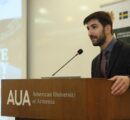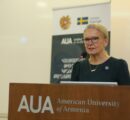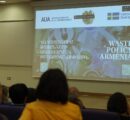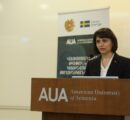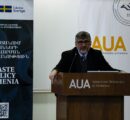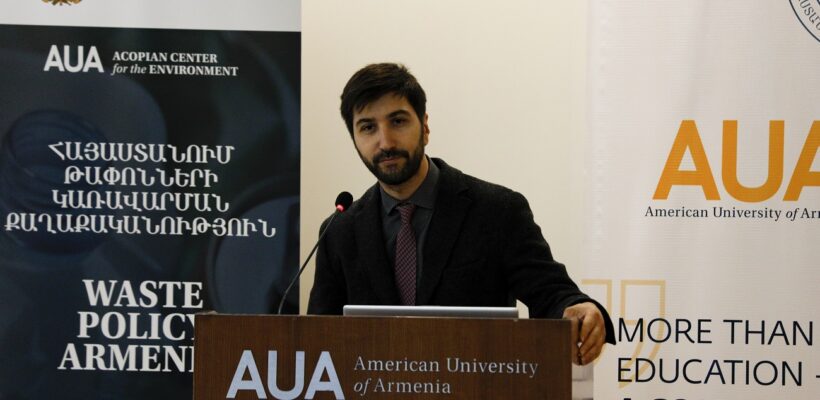
Waste Policy Armenia Launched
2 min readYEREVAN, Armenia — On October 28, the American University of Armenia (AUA) Acopian Center for the Environment, the Republic of Armenia (RA) Ministry of Environment, and RA Ministry of Territorial Administration and Infrastructure jointly launched the Waste Policy Armenia (WPA) funded by Sweden. The event, held at AUA, was attended by representatives of the ministries, embassies, academia, and field experts.
The four-year USD 3.5 million program managed by the Acopian Center aims to achieve three main objectives: to support the RA Ministry of Environment in developing and adopting an Extended Producer Responsibility (EPR) system based on EU best practices; to support the RA Ministry of Territorial Administration and Infrastructure in the development of a national model for source separation of solid waste and introduce it as a system in Sevan Town and other target municipalities; and to build sector capacity for scaling up the program results achieved.
“EPR is a policy tool that makes producers or importers responsible for the waste generated from consumption of their products. EPR ensures that the polluters (or producers of waste) pay for the full cost of recovery and do not transfer costs related to managing post-consumer materials to municipalities,” explained Harutyun Alpetyan, the AUA Acopian Center program manager for WPA. “The EU and many other countries around the world are instituting EPR systems to deal with the big and growing problems of packaging, electronic, automotive, and other types of waste. Based on its agreement with the EU, Armenia is expected to adopt an EPR system by 2024,” he added. 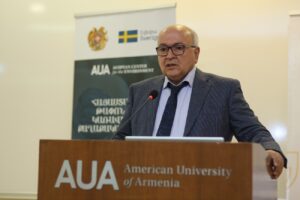
RA Deputy Minister of Territorial Administration and Infrastructure Vache Terteryan emphasized the significant contribution WPA will make in the implementation of an integrated solid waste management system in Armenia’s communities. “By introducing source separation of waste, this program will help the Kotayk and Gegharkunik Solid Waste Management Project [which builds a sanitary landfill and collection infrastructure], thereby creating a complete and integrated system of solid waste management in the region. Subsequently, the lessons learned from the program will be scaled up in other communities of Armenia.”
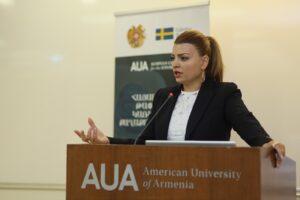 According to Deputy Minister of Environment Gayane Gabrielyan, this is a unique collaboration between the governments of Sweden and Armenia, involving academia, that contributes to solutions to one of Armenia’s important challenges. “Waste management is essentially one of the most important elements of the environment and circular economy agenda in the context of the green agenda,” she remarked.
According to Deputy Minister of Environment Gayane Gabrielyan, this is a unique collaboration between the governments of Sweden and Armenia, involving academia, that contributes to solutions to one of Armenia’s important challenges. “Waste management is essentially one of the most important elements of the environment and circular economy agenda in the context of the green agenda,” she remarked.
“The tools and approaches developed by the program will help our government fulfill its obligations and advance the green economy agenda,” Harutyun Alpetyan summed up.
The event set the stage for strong collaboration among public, private, and academic sectors to advance the transition towards a circular economy in the country through increased awareness, capacity building, and improved infrastructure.
The AUA Acopian Center for the Environment, a research center of the American University of Armenia (AUA), promotes the protection and restoration of the natural environment through research, education, and community outreach. The AUA Acopian Center’s focus areas include sustainable natural resource management, biodiversity protection and conservation, greening the built environment, sustainable energy, as well as information technology and the environment. Visit http://ace.aua.am.
Media Coverage:
[Armenian Public TV] Կառավարելի թափոններ. քառամյա ծրագրի մեկնարկը Հայաստանում
[1in.am] Մեկնարկել է «Հայաստանում թափոնների կառավարման քաղաքականություն» 4-ամյա ծրագիրը
[Free News] Թափոնների վերամշակման խնդիրը լուծվում է
[A1+] ՀԱՀ-ում քննարկում են թափոնների քաղաքականության բարելավման ուղիները
[Aravot] Բազմակի օգտագործման տոպրակներ ենք ցուցադրական բաժանելու. ՀՀ շրջակա միջավայրի փոխնախարար

